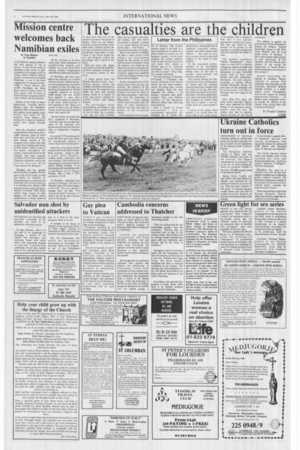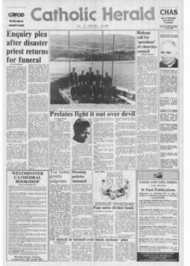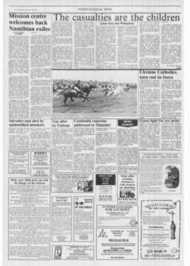Page 2, 30th June 1989
Page 2

Report an error
Noticed an error on this page?If you've noticed an error in this article please click here to report it.
Tags
Share
Related articles
Zone Of Peace Is Priority For Bishop Of Bacolod
Children Of Fatima
Sorrow And Joy
Insisting On A Funeral Mass
A S I Stood Waiting In The Studios Of Independent Television
The casualties are the children
Letter from the Philippines
IT must have been one of the loneliest funerals in the parish of Sipalay. There was one solitary mourner, the grandmother of the dead child, walking behind the cart that carried the coffin of her grandchild, Angie Mate. A male friend of the family pulled the cart and alongside walked the gravedigger with a shovel in his hand.
Only two years old, Angie succumbed to a measles epidemic currently sweeping through the 17 evacuation centres in this town.
A small group from the Manile-Bacolod-Cebu factfinding mission joined the cortege in the dusk procession to the graveyard. We made our way under the trees and around cement tombs to a cluster of newly dug graves marked by wooden crosses and fading flowers.
The gravedigger made measurements and began to dig alongside a little mound of clay on top of which lay a wooden cross with the name 01 lando Mate. He was Angie's four-yearold brother who had earlier succumbed to measles. A priest in our group blessed the grave and we said — "Our Father . . ." around the little grave of Angie.
Back in the convent of Sipalay the 8pm to 4am curfew's eerie stillness was intermittently broken by the sawing of wood and the thud of a hammer. From the window, one could see the silhouette of men working by the rusty-gold flicker of an oil lamp. Curiosity urged some members of the fact-finding mission to go down and investigate.
As they entered the door of the church annexe where the men were working, the members of the mission did not have to ask. The evidence was there for them to see: three carpenters — thin, wiry men from the mountains of Manlocahoc — were making coffins with borrowed tools for three of their neighbours' children who had also died of measles in the evacuation centres.
Every situation, however grim,
has its humour. One mission member asked if the body of a man stretched out in sleep on a plank beside the coffin was the bangkay, (corpse). At the word bangkay, the "corpse" suddenly woke up and sensing that he was very much alive, smiled at himself and at us. Someone apologised, "Sorry, we thought you were a 'corpse'." Okay-lang, the "corpse" answered.
The next morning, Fr Brendan O'Connell, a Columban, and myself officiated at the funeral service for the three children. About 30 young men, women and children lined the aisle alongside the coffins — all solemn, shocked and griefstricken. They were Filipino replicas of the Madonna Dolorosa whose tears had long since dried up.
After a month of forced evacuation — with its concomitant dislocation, the breaking up of family life, malnutrition, unbearable heat in congested evacuation centres, sickness and death among their children — they had no more tears to shed, inured to pain and resigned to the death of their children.
At the evacuation centres, members of the fact-finding mission saw infants and children ebbing away on the tide of measles, gastro-enteritis and broncho-pncumonia.
One mother fanned the flies from the face of her child gasping for breath and life. Another shocked and listless mother held her infant on her lap. The baby had refused to stickle for the past three days. The distressed mother put a cap on the head of the child and wrapped its wasted body with bits of clothes — the last visible token of a poor mother's love.
A priest in the group asked himself it he should bless the dying child or give some money to the mother. But it seemed to him that it was neither appropriate to bless nor to give. One was just called at this moment to be present to the mystery of a mother giving back with love and pain her infant to God.
The military operation, "Oplan Thunderbolt", which began on April 24-25 in Sipalay to flush out rebels in the hills and resulted in the evacuation and dislocation of some 30-40,000 people, most of them small farmers and their dependents. Ominously, the only casualty, according to Sipalay Mayor Soledad Moontilla during the early days of the campaign was three-months old Boyet Herosiclo who was caught in the crossfire.
Since those first days, the rising infant mortality figures have been reported at 26-50. Women in the evacuation centres, however, insist that over 100 children have died in southern Negros because of the forced evacuation.
The military is against the participation of church people in helping the refugees. General Raymundo Jarque of the 301st Army Brigade told the local parish priest, Fr Hernaez, "I don't want human rights groups to take advantage of this situation. And the Church must channel its aid throgh the Department of Social Welfare and Development, not directly to the evacuees."
Despite everything, the Church in southern Negros continues to minister both spiritually and materially to the evacuees, Bacolod Bishop Antonio Fortich, in a public appeal, wrote: "Emergencies such as this require the helping hand of every Christian . . . we deplore some misguided moves to exclude the efforts of the Church from giving them (the evacuees) assistance."
Fr Frank Connon CSSR
blog comments powered by Disqus











